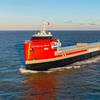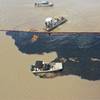USCG Activates Rescue 21 System in Gulf States
Advanced direction-finding capability, a critical component of Rescue 21, allows Coast Guard watchstanders to more accurately locate the source of a distress call. That capability also allows the Coast Guard to locate the source of hoax calls. Rescue 21 also includes a network of towers to help reduce coverage gaps in coastal areas and ensure more calls get through to the Coast Guard.
Proving its mettle following Hurricanes Katrina and Rita, is the Disaster Recovery System (DRS), a critical component of Rescue 21. A fully autonomous, rapidly deployable emergency communications package, it provides voice and data connectivity if a man-made or natural disaster destroys the existing communications infrastructure. The DRS connects to the Coast Guard Data Network (CGDN+) via satellite communications. For six months, it reliably provided one-way communications with mariners, in the southeastern portion of the Mississippi River and Gulf Coast region. Currently, four of the deployable systems are staged in Huntsville, Ala. for quick deployment.
The National Oceanic and Atmospheric Administration has predicted eight to 10 hurricanes in the Atlantic for 2006; at least half of which are expected to be the strength of Category Three storms. "Rescue 21 has been accepted at an especially critical time of year in the Gulf States," said Abel. "It provides vital technology to increase the capabilities of our Coast Guard crews at a vital time when summer search and rescue pace increases and tropical storms or hurricanes put mariners and coastal residents at risk," he said.
A $730 million acquisition project and the second largest within the Coast Guard, Rescue 21 will replace the Coast Guard's aging National Distress and Response System, built during the 1970s. Once fully implemented, Rescue 21 will cover 95,000 miles of U.S. coastline and inland waterways.










